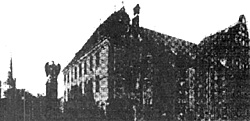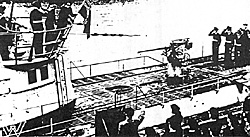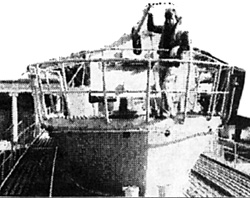Former crew member with assignment Control room of this very vessel until we got captured in a running battle between the Coast off Cape Blanco, French West Africa and the Cape Verde Isles, on 4 June 1944, by the so-called (Hunterkiller) Task Force Group 22.3 GUADALCANAL, US Navy Atlantic Fleet, consisting of Aircraft carrier USS GUADALCANAL, and five destroyer escorts: CHATELAIN, FLAHERTY, JENKS, PILLSBURY and POPE.
"When I joined the Kriegsmarine (German Navy), I was 17 years old and at 18 1 became a crew member of U-S05. After performing 1/4 of a year basic training in a big navy training center in Bourg Leopold, Belgium (learning how to creep), 1/4 of a year Submarine school - Course U-Electrotechnic at the 1st ULD (U-Boot-Lehr Division) at Pillau, East Prussia, Baltic. Because of my good review, I got ordered directly to the 2nd Submarine Flotilla at Lorient on the French Atlantic coast, instead of to a shipyard in Germany where submarines were built.
 Training School 'Falklandkaserne'
Training School 'Falklandkaserne'
"More than 95% of all submarine crews had volunteered for the Navy were hand-picked out of thousands after they went through different physical and psychological examinations. At that time, belonging to the submarine forces had been a distinction, and our spirits were high and in a strong belief to fight for our country.
"Until the end of the war the submarine service has never been short on volunteers. We had a very rough and hard drill, but we knew that without it there was only little chance to survive ... we had to know every handle, valve, cranny and nook, even in darkness... but also a lot of theory. The capture was only the end of the contributions U-505 added to the effort of the Kriegsmarine to win the battle at sea.
"The pattern of her operations was typical of most U-Boats. The only difference is, she sunk 8 ships with together 47,000 Gross or British Register Tons, and saved the lives of 33 sailors and the captain of the German torpedoboat T-25, which was sunk in a battle against one heavy and a light British cruiser almost exactly at the same spot where T-25 three months before, had saved most of the crew of U-106, also from the 2nd Submarine Flotilla, Lorient while most of the other U-Boats were sent to the bottom of the sea, in most cases with loss of all hands, without sinking a single ship. From 39,000 U-Boat crews, 32,000 lost their lives -- 27,000 are resting in their "iron coffins" in almost all oceans and seas.
 U-505 at Commissioning.
U-505 at Commissioning.
"U-505 is a Type IX-C Boat. One of the big, long-range front service boats. This type of submarine ran most of the time single in an operation area, designated by GrossAdmiral Karl Donitz.
"Her keel was laid on 12 June 1940 at the "Deutsche Werft" HamburgFinkenwerder. Her launching date was 24 May, 1941. Her first trial run on the river Elbe was on 30 July, 1941, and the take-over run was on 13 August. Hoisting the flag for the first time and put in commission took place on 26 August 1941. She had a displacement of 1, 120 tons on the surface and submerged 1,232 tons.
"Her dimensions are: 252 feet long, 221/4 feet high, and 151/4 feet wide in the middle section, from keel to tip of periscope 44 1/2 feet or 14 meters, called periscope depth.
"Machinery: 2 shaft diesel and electric engines, both 9 cylinder M.A.N. diesels with together 4,400 HP; 2 Siemens Electric engines, also being used as generators for charging the 110 volt batteries and electric welding with together 1,000 HP, with an average speed of 12 knots (diesel). With 208 tons of diesel fuel, she could take us over 12,000 miles without refueling. Top speed was 18 1/4 knots. The electric engines took us (with fully charged 11 OV DC) and a speed of 4 knots - 63 miles. Top speed 71/4 knots to save energy. Most of the time we ran average speed electric engines to be able to stay submerged longer.
"She carried 22 torpedoes and had four tubes forward and two astern. Dimensions - 21 inches i. d. Armament. The U-505 made her first two war patrols with the standard conning tower, carrying one single barrel 20mm AA gun on the bridge, one 37min AA gun behind the conning tower, and one 10.5cm artillery deck gun in front of the tower.
"Early in 1943 we got a completely new conning tower, caused through the damage of getting bombed on 1 Oth November 1942 off Trinidad in the Caribbean. There was no use for the 10.5 cm deck gun anymore. So it got taken off. The less weight of it gave us parts of the new weight for a larger conning tower with the so-called "Wintergarten" taking up, but only for one short patrol, a 4-barrel 20mm. AA gun on the Wintergarten, and two twin-barrel 20mm AA on the bridge. Thereafter the 4-barrel got replaced by a 3.7 cm Oerlikon-automatic AA gun, which worked perfectly ... until the day of our capture.
26 August 1941, the boat was put in commission under the command of Kptlt. Axel Olaf Loewe. He had just finished a war patrol on U-74 as "Conunandantenschii1er" and came now after finishing Commanding Officer's School.
"His first address to his crew as given in very clear words:
"'Comrades, as commandant of U-505, I have come here to Hamburg in order with your help to take our boat to the front, after our short shake-down and war training maneuvers. It will be a hard life - have no illusions about that. But with a well-disciplined crew, we'll have our successes.'
"One quarter of a year the crew was engaged in gunner-torpedo and tactical exercises in the Baltic Sea. During this time the surface "concurrence" gave our crew the first taste of the reality of war. They dropped depth-charges called "Wabo's " (water bombs), while our boat was on submerged run, so that everybody knew what they sounded like. But the next time we would hear them, they wouldn't be dropped for training purposes.
"In December the boat returned to the builders yard at Hamburg for alterations and minor repairs. By the end of December, 194 1, we went to Stettin (Baltic) for loading stores. Oil-Diesel fuel and ammunitions. This had been quite an operation in itself. There were supplies everywhere. It seemed impossible that this mountain would find a place inside the pressure hull.
 U-505 Modified with new conning tower.
U-505 Modified with new conning tower.
"The torpedo tubes were loaded with "Aale " in other Navies, called "fish". We called them "eels". Front and aft torpedo rooms were sleeping and living rooms at the same time for off-watch crew too, but there were also five torpedoes stored and tied down in the front room, which had to be used as sleeping places for four poor sailors on top of them. In the aft torpedo room there were three torpedoes tied down, also were used as sleeping places for two offwatch sailors and 4 or 6 hours later used by those who had been on watch during that time. But very often they could not use their greasy beds, because the torpedo mechanics had to maintain the aale. It was the same thing in using the bun bunks. These were still warm when
The guy who came from watch, tried to find a couple of hours sleep on it. Anyhow eight more torpedoes were stored outside the pressure hull on the so-called 'free floating' upper deck in pressure and waterproof tubes. It always had been a most dangerous business getting them from upperdeck either into the front or back torpedo rooms at sea, because until this hard job was done, there was no chance for getting away from the surface. With the torpedo hatch open the boat would sink within a couple of minutes time.
"Now let's carry on getting the boat loaded with only necessary things: The seabags stacked high between the torpedo tubes were left there till all those boxes, crates, cartons, cans and a lot more of little and big things were stored at its places by storing list and number. Behind the electric engines, the diesels, even some things in the bilges. Sacks of potatoes were squeezed beside the chart table in the control room, where they started to rot, right after the first time we submerged. Can you imagine the stinking smell, mixed with the smell of diesel fuel and everything which produces a more or less perfume and odor of its own nature, even the bodies of 60 men?
Hammocks and nets filled with fresh bread which became moldy after two or three days already, strung up high in the torpedo hatch area front and back, even when there were only little pieces left, which were kind of white looking instead of green, we ate them. At the look of all this it seemed rather to be a bazaar than a weapon of war. But with each more time we had to repeat this maneuver, we got less bothered by all of it. At this phase of the battle in the Atlantic, our U-Boats were still on the winning side, and having great luck on the hunt, so there wasn't anything that could change our minds.
"The first patrol began at noontime on 19 January, 1942. U-505 had been assigned to the 2nd Submarine Flotilla at Lorient, French Atlantic Coast. The course had been to the North Sea and around the British Isles. We went through between Shetland and Faroe. At this time U-505 had no orders to hunt, but if there was a good chance, there would not have ben a reason not to sink anything.
Very soon, boat and crew had the best occasion to show if they were prepared for going to the front. Very heavy weather came up and the course went through an area with heavy enemy watch. But our luck that they had the very same weather, and there was only little chance to attack, for both sides. Reason enough for running high speed on the surface. Only one time a day our boat dived for about 2 hours, getting trimmed and for minor repairs.
On the 25th of January, the Bridge Watch spotted in the distance a British destroyer. U-505 did not dive, though, and did not attack either, nor did the destroyer attack us. The weather really was too bad for lining up an attack.
"After 16 days passage, on 3 February, two minesweepers and one Blockeship escorted U-505 through the heavily mined waters off Lorient into her home base. There was a Navy band on the pier and hundreds of different people to welcome another "New Boat". There was also the Flotilla staff waving their hands. The crew lined up in front and behind the conning tower. One could feel their hearts pulsing. It was really a great feeling being the attraction of the day.
Then from the dockside came: "We greet the U-505 and her crew with - Hurrah - Hurrah - Hurrah!" In this manner we received the welcome in the most famous and successful Flotilla in the whole U-Boat force.
"We felt ourselves safe in them 16 tremendous concrete bunkers with reinforced 22 foot thick roofs. Rehabilitation camps and facilities unparalleled in the whole Wehrmacht --and all that-- just for us and our comrades.
"At 10:00 on 6 February, Admiral Donitz gave the U-505 his official welcome."
More U-505
Back to KTB #104 Table of Contents
Back to KTB List of Issues
Back to MagWeb Master Magazine List
© Copyright 1994 by Harry Cooper, Sharkhunters International, Inc.
This article appears in MagWeb (Magazine Web) on the Internet World Wide Web. Other military history articles and gaming articles are available at http://www.magweb.com
Join Sharkhunters International, Inc., PO Box 1539, Hernando, FL 34442, ph: 352-637-2917, fax: 352-637-6289, www.sharkhunters.com
